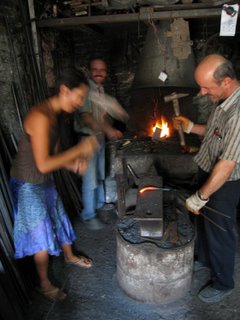Rama-what? No really, what are the rules here? I admit my circle of friends and acquaintances at home has never included many muslims, that I’m aware of. Therefore it was surprising to me to learn that one of the pillars of Islam is the observance of Ramadan. The dates change every year, but it’s always 30 days. This year it’s Sept 24 to Oct 23. Lucky us we get to experience it while we’re traveling through Turkey, Jordan, and Egypt. What we’ve heard is that during this time good muslims cannot eat or drink ANYTHING from sunrise to sunset. This year that means from 6am to 7pm no bread, no tea, not even water, nothing means nothing. After sunset there are gorging parties all over town. Also, they must pray 5 times during the day, including at 4am, and all efforts are to be exerted to do so at a mosque. This not only scrambles a lot of public services like transportation and office hours, but also puts people in bad moods since they thirsty and starving all day. And they have to go cold turkey with alcohol because it is strictly forbidden during this month, more so than the rest of the year when some of the rules are more loosely interpreted. There are other particulars like the sacrifice of a goat, etc. that we haven’t been able to get all the particulars on. So we weren’t sure what to expect in Istanbul since it is very much a modern city with enormous western influences but is nonetheless muslim. In the morning my belly was already on empty so we walked around trying to spy if any non-tourist was eating or drinking. As it was a Sunday, their only day off, the streets were quiet. I was getting pretty desperate and ready to buy snacks to scarf in the hotel when we did catch some local looking peeps sipping in cafes. There was nothing that indicated that this was day was any different from the last. So on the first day of Ramadan my true love gave to me, a McDonald’s hamburger.
-Mary
Wednesday, September 27, 2006
The 30 days of Ramadan: Day One
Posted by
steve
at
6:59 AM
2
comments
![]()
Ode to the Sea

So much time amongst the rock,
Hence we yearned the sea to frock.
Sent off by the flaming Chimera,
To sail pass the land of Lycia.
Here a city given to fish,
And lived jolly saint Nicholas.
Aboard the gulet waves we ride
To nap, idle, and tan our hide.
No cares, worries, nor questions why,
Four days thus sailed by.
-Mary
The Blue Cruise as it’s called sails across the southwestern Turkey coast from Olympos to Fethiye. In 4 days, 3 nights it goes the distance that it takes a bus one and a half hours to cover. And that’s pretty much the pace of life on the 78’ wooden gulet. Your day is your own and although there were 16 other passengers and 3 crew there is ample space to spread out and enjoy the peace. Each day the vessel would stop in a couple of locations to see the sites, stretch the legs, and have a swim. Three warm meals a day, plus a snack, were prepared by the cook who looked like a cheerful surf bum. He made all kinds of good stuff like stuffed peppers, French toast, and fish-head soup from the captain's morning catch. The soup wasn't much to look at because it stared right back, but it tasted good. The cabins were spacious doubles each with their own shower and head that flushed. The last night we opted to sleep under the skies on the deck. The gulet is really nicely set up for lounging with cushioned beds for laying out, canopies for the whities, and even a hammock at the bow. To break up our napping, Steve entertained with cliff jumping. 
We were very pleased with the quality and experience given the price was half what it would cost in the States. We would highly recommend doing this for anyone going to Turkey and looking to relax under the sun.
-Mary
Editor's note: we had lunch in Demre, which is the home of one Saint Nicholas they claim as the inspiration for modern day Santa. No presents dropped through our porthole, though.
Posted by
steve
at
6:51 AM
0
comments
![]()
McDonalds Playland - Turkish Style
Cappadocia is a region of central Turkey that is covered in bizzare rock formations, some of 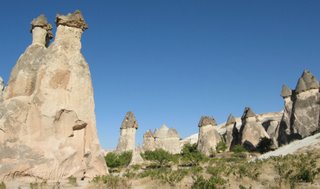 which are visually similar to Bryce Canyon in Utah. Millions of years ago, a bunch of soft tufa was covered by some hard lava. Once the lava cracked up, the tufa wore away much faster and the result are cones or cylinders of tufa protected by caps or mushrooms of lava.
which are visually similar to Bryce Canyon in Utah. Millions of years ago, a bunch of soft tufa was covered by some hard lava. Once the lava cracked up, the tufa wore away much faster and the result are cones or cylinders of tufa protected by caps or mushrooms of lava.
Atleast that's what the geologists will have you believe, but the locals have another theory. They want to believe.
but the locals have another theory. They want to believe.
What makes this area even more interesting is that the Hittites living here a few thousand years ago used all this soft stuff to carve themselves some homes and hiding places so the area is blanketed in three major types of sites: cool shaped rocks, rocks with homes or Christian churches carved into them, and underground cities carved into hills.To the modern tourist, it is a playground for hiking the valleys, climbing higher than you should to see frescoes in the churches, wandering through the remains of ancient apartment complexes and getting lost and dusty in dark winding caves. We stayed here 7 days in a town called Goreme and balanced a few big hiking and scootering days with some naptime. The first big hike day, we did some good off trail climbing through a couple canyons, up through vineyards and pumpkin patches on the plateaus and down through a valley of absolutely phenomenal fun.
Posted by
steve
at
6:47 AM
0
comments
![]()
Tuesday, September 26, 2006
Digging their way to China
The undergroud cities are possibly even more impressive than the sites up top. The locals claim there are hundreds of cities of varying size and excavation in the area. The largest we saw claimed to be excavated to 8 levels below ground with some 5000 rooms discovered. This first city at Kaymakli is very clean and setup for tourists. There's even lighting run through most of the rooms. Of c ourse, we spent a fair amount of time off the beaten path with only our headlamps for light. I think most impressive is the little stuff. There are ventilations shafts running up and down further than our lights can see. The round stone doors that roll in place to block passageways from enemies.
ourse, we spent a fair amount of time off the beaten path with only our headlamps for light. I think most impressive is the little stuff. There are ventilations shafts running up and down further than our lights can see. The round stone doors that roll in place to block passageways from enemies.
After this big one,  we headed on our scooter out to the country to a speck of a town called Mazi with a less touristed underground city. A guy by the side of the road flagged us down and offered to show us inside with his gas lantern. There actually were lights put in when a group of archeologists started excavation, but they seemed to have stopped rather abruptly and ripped out the lighting and most of the wiring when they left. Our guide tells us in some mix of Turk, English and French that this city was built for 10,000 people to hide out. This one went six levels below surface and six up into a mountain, but only the upper ones were open. In near darkness, we followed this guy around this dirty group of chambers until he says "Now surprise. follow slowly" and runs off down a narrow passage with the big lig
we headed on our scooter out to the country to a speck of a town called Mazi with a less touristed underground city. A guy by the side of the road flagged us down and offered to show us inside with his gas lantern. There actually were lights put in when a group of archeologists started excavation, but they seemed to have stopped rather abruptly and ripped out the lighting and most of the wiring when they left. Our guide tells us in some mix of Turk, English and French that this city was built for 10,000 people to hide out. This one went six levels below surface and six up into a mountain, but only the upper ones were open. In near darkness, we followed this guy around this dirty group of chambers until he says "Now surprise. follow slowly" and runs off down a narrow passage with the big lig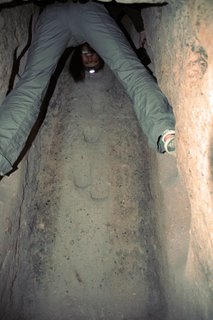 ht. We follow and a minute later I see his light - and Mary screams. I turn to see two arms sticking through small holes in the passageway hovering over her. Another great trick to pummel your enemies.Next we have to ascend four levels through 3 foot square 'elevator' shafts that rise along the wall and straight through the ceiling as far as our lights shine. (The brightness of the lighting in thes
ht. We follow and a minute later I see his light - and Mary screams. I turn to see two arms sticking through small holes in the passageway hovering over her. Another great trick to pummel your enemies.Next we have to ascend four levels through 3 foot square 'elevator' shafts that rise along the wall and straight through the ceiling as far as our lights shine. (The brightness of the lighting in thes e pictures is boosted by Photoshop - which wasn't much help to us at the time!)
e pictures is boosted by Photoshop - which wasn't much help to us at the time!)
There are footholes on 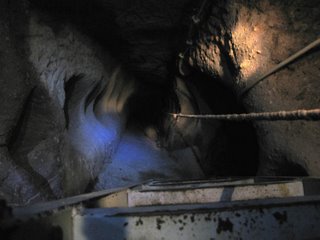 each side every foot, so climbing up is just a matter of wedging your self in and going up. Fear of heights isn't much of a problem because there's nothing to see when you look down.
each side every foot, so climbing up is just a matter of wedging your self in and going up. Fear of heights isn't much of a problem because there's nothing to see when you look down.
This adventure was just missing the Indiana Jones theme song in the background. After a few shafts, a knee height tunnel or two and the promise of no more "surprises", we made it safely outside again. Now we just need to find a laundry service.
Posted by
steve
at
12:26 PM
2
comments
![]()
Meet the Flintstones
 Our first big hike in Goreme took us through Pigeon Valley where we came across a 4 story building carved into the hill that we couldn't resist. We wandered the first two floors which are completely covered in pockets such that the place looks like a library. We later learned that people here raised pigeons to eat, make fresco paint from the eggs, as message carriers, and used their guano for fertilizer.
Our first big hike in Goreme took us through Pigeon Valley where we came across a 4 story building carved into the hill that we couldn't resist. We wandered the first two floors which are completely covered in pockets such that the place looks like a library. We later learned that people here raised pigeons to eat, make fresco paint from the eggs, as message carriers, and used their guano for fertilizer. 
 A bit later we came across this building which is a giant tufa cone of swiss cheese chambers and passageways. It is some kind of apartment or group dwelling that we called the Penthouse. The real beauty of this whole area is that there are no park rangers or signs that say "don't go here". Everything is open to be explored if you can get to it. That said, we wandered through hundreds of rooms going all the way to the top eight stories up, but still saw maybe only a third of it.
A bit later we came across this building which is a giant tufa cone of swiss cheese chambers and passageways. It is some kind of apartment or group dwelling that we called the Penthouse. The real beauty of this whole area is that there are no park rangers or signs that say "don't go here". Everything is open to be explored if you can get to it. That said, we wandered through hundreds of rooms going all the way to the top eight stories up, but still saw maybe only a third of it.
Posted by
steve
at
11:51 AM
0
comments
![]()
Full of hot air
 At the end of the day, we're tourists. And the #1 tourist thing to do in Cappadocia is to wake up at 5am for a hot air balloon ride. There are about 15 balloons that take off each morning in neighboring fields carrying three or four hundred people. The crowds are forgotten very quickly as we watch each balloon fill up with its massive bunsen burners. What can we say, we're both fans of flame and we got our fill this day.
At the end of the day, we're tourists. And the #1 tourist thing to do in Cappadocia is to wake up at 5am for a hot air balloon ride. There are about 15 balloons that take off each morning in neighboring fields carrying three or four hundred people. The crowds are forgotten very quickly as we watch each balloon fill up with its massive bunsen burners. What can we say, we're both fans of flame and we got our fill this day. 
Once in the air, we saw the expected incredible views of Goreme and the surrounding valleys and town s. We quickly moved right up next to one of the couple hundred foot tall tufa cone apartment buildings and then ran up to about 4500 feet above ground level.
s. We quickly moved right up next to one of the couple hundred foot tall tufa cone apartment buildings and then ran up to about 4500 feet above ground level.
Then we drifted over town and out towards a few valleys and our landing site. The pilot had some creative ideas about landing, though, and three times sent the ground crews running across vineyards only to take off on them and drift across another valley. Bad for them, good for us!
Posted by
steve
at
11:27 AM
0
comments
![]()
Wheels on the bus go round and round
We were introduced to overnight buses in Morocco and Greece had their fare share of long rides, but I think the Turkish were born on buses. Before we leave Turkey we will have spent 120hr+ on long hauls rides. Many were overnighters that range from 8-17hr journeys. They’re not fun but it’s the best way to get around this country. After tossing your bag in the storage compartment below, hoping desperately that it’ll be there when you arrive, you’re directed up the stairs to your assigned seat. The bus quickly fills up because there is no such thing as an empty seat. Usually children sit on laps to avoid being charged an extra fare. When seats are oversold the extras are given plastic stools to c rouch on in the aisles. Shortly after departing, a steward comes by and offers a beverage and a packaged snack followed by squirts of lemon disinfectant for your hands. Throughout the night you stop to drop-off or pick-up passengers at what seems like the side of the road in middle of nowhere. Just when you start dozing off the lights suddenly come to life for the hourly stops for a snack break, toilet break, smoking break, or tea break. Sometimes they’ll slow down so the steward can unceremoniously flail the plastic bag of trash out the side door. Turkey’s very 3rd world in the way they treat their rubbage. The only way we’re able to get any sleep on the overnighters is to tire ourselves out during the day then try to block out the world with earplugs and eyeshades. Even then we’re lucky to get four hours of sleep regardless of the length of the journey. At some unreasonable hour of dawn they wake you up and toss you and your bags off the bus to let you know you’ve reached your destination, leaving you to figure out the next step half asleep and aching for a chiropractor.
rouch on in the aisles. Shortly after departing, a steward comes by and offers a beverage and a packaged snack followed by squirts of lemon disinfectant for your hands. Throughout the night you stop to drop-off or pick-up passengers at what seems like the side of the road in middle of nowhere. Just when you start dozing off the lights suddenly come to life for the hourly stops for a snack break, toilet break, smoking break, or tea break. Sometimes they’ll slow down so the steward can unceremoniously flail the plastic bag of trash out the side door. Turkey’s very 3rd world in the way they treat their rubbage. The only way we’re able to get any sleep on the overnighters is to tire ourselves out during the day then try to block out the world with earplugs and eyeshades. Even then we’re lucky to get four hours of sleep regardless of the length of the journey. At some unreasonable hour of dawn they wake you up and toss you and your bags off the bus to let you know you’ve reached your destination, leaving you to figure out the next step half asleep and aching for a chiropractor.
-Mary
Posted by
steve
at
11:15 AM
0
comments
![]()
Falling on deaf ears
Eastern Turkey has been full of historical and religious significance. We saw the Tigris and Euphrates rivers in Mesopotamia, gazed up at the fortress where Abraham was flung down by God to land in a bed of roses, smacked our lips over the sacred carp but didn’t dare try to catch them for fear of going blind, and smelled feet in the tiny underground cave where the prophet Job spent seven years and I can’t recall what else. Most of this stuff is really wasted on us, but the stories make looking at rubble and holes in the mountains much more interesting. There’s really too much to remember and take in; it’s a real bummer there’s no cliffnotes for the Kuran. The closest thing we found is a book titled “The Crisis of Islam”, which Steve had to read very discretely given present company.
-Mary
Posted by
steve
at
11:01 AM
0
comments
![]()
Tuesday, September 19, 2006
Out of time
Bummer I have a really poor net connection and we need to catch a boat so the rest of the pix must wait. We are jumping now onto a 4 day sailing cruise along the coast from Olympos to Fethiye.
Posted by
steve
at
2:25 AM
2
comments
![]()
Lost Days in Eastern Turkey
We spent about a week running right along tense borders in the east and south of Turkey: Armenia, Iran, Iraq and finally Syria. Even more tense is the mood in this part of Turkey because it is where the Kurdish separatists call home. Yeah, those Kurdish separatists who keep bombing the tourist areas of Turkey. The military checkpoints actually got a little tiring after a while as they mean extra time on the bus. The trip from Doyugabazit to Van, through Batman to Diyabakir, off to Mardin and then to Urfa, Harran and Mt. Nemrut was through the frontier and agricultural heart of Turkey. People tended to be very friendly, if for no other reason than the curiosity of passing Americans. 'beehive' houses ın Harran next to the Syrian border. Note the TV antenna...
'beehive' houses ın Harran next to the Syrian border. Note the TV antenna...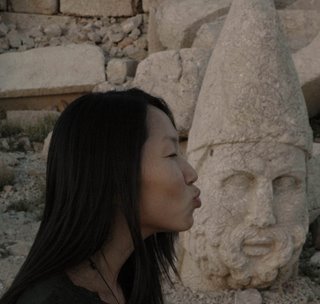 Mary playing kissie with the Travelocity Gnome at Mt. Nemrut
Mary playing kissie with the Travelocity Gnome at Mt. Nemrut
Rest of the family at Nemrut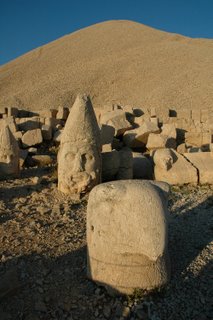
 Batman: İ don't need to make this stuff up. There's really a town named Batman. We just passed through, but long enough to note that the bus station looks a lot like the Hall of Justice. Really, it was quite funny. But the bus didn't stop there so no picture :( I also wasn't fast enough to get a picture of the Batman ambulance we saw in Diyarbakir. Gotta be quicker with the lens. The picture here is from a bus company in the next town advertising service to Batman.
Batman: İ don't need to make this stuff up. There's really a town named Batman. We just passed through, but long enough to note that the bus station looks a lot like the Hall of Justice. Really, it was quite funny. But the bus didn't stop there so no picture :( I also wasn't fast enough to get a picture of the Batman ambulance we saw in Diyarbakir. Gotta be quicker with the lens. The picture here is from a bus company in the next town advertising service to Batman.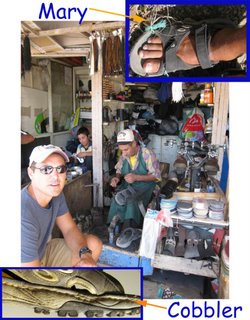 My Shoe, Part 2: I tore the leather out of the sole of my sandals hiking in the Kackar mountains last month. Mary fixed it up with some twine and that kept me going until Diyabakir. A rug salesman noticed the repair and as his opening line said something to the effect of "nice to see there are Americans as poor as we are". Not 10 minutes later, we stumbled across a row of cobblers and gave one a chance to disguise my poverty. The bottom picture is the stitching that resulted. That was a couple weeks ago and it's still holding strong. Pay attention Merrell!.
My Shoe, Part 2: I tore the leather out of the sole of my sandals hiking in the Kackar mountains last month. Mary fixed it up with some twine and that kept me going until Diyabakir. A rug salesman noticed the repair and as his opening line said something to the effect of "nice to see there are Americans as poor as we are". Not 10 minutes later, we stumbled across a row of cobblers and gave one a chance to disguise my poverty. The bottom picture is the stitching that resulted. That was a couple weeks ago and it's still holding strong. Pay attention Merrell!.
Home cooking:We've become really tired of Turkish food. It's good and all, but after a few weeks we very much craved anything else. Luck came in the form of a Burger King in Diyarbakir. There's no two ways to look at it. We had two meals in the town and both were Burger King. And they weren't small meals. We gorged. Now that we're back in civilized Istanbul, this process is out of control. We've already had Slotchkey's Deli, Pizza Hut and McDonalds (twice).
Posted by
steve
at
2:11 AM
1 comments
![]()
Thursday, September 07, 2006
Welcome to the freak show
 I enjoy the friendly local that strikes up a conversation and inquires about my ethnicity, which seems to be a real novelty for them. But when literally 9 out of 10 people on the street yell at me as I pass taking wild stabs at my country of origin, it quickly adds up to hundreds of unsolicited and identical questionnaires over the course of a week for every week we’ve been in rural Turkey where we’re the only foreigners around. Sometimes this creates a rowdy entourage of local youngsters. Near the Iranian border in Doyubayazit we were climbing up a rocky bluff to the rubble of some 13th BC fortress when some picnicking locals stopped to take pictures of and with us. They were very
I enjoy the friendly local that strikes up a conversation and inquires about my ethnicity, which seems to be a real novelty for them. But when literally 9 out of 10 people on the street yell at me as I pass taking wild stabs at my country of origin, it quickly adds up to hundreds of unsolicited and identical questionnaires over the course of a week for every week we’ve been in rural Turkey where we’re the only foreigners around. Sometimes this creates a rowdy entourage of local youngsters. Near the Iranian border in Doyubayazit we were climbing up a rocky bluff to the rubble of some 13th BC fortress when some picnicking locals stopped to take pictures of and with us. They were very  friendly and courteous but they followed us like paparazzi, curious about everything we did and continually making attempts at conversation. As we left they lead us to their family at the make shift park below to take some more pictures. Upon approaching the women practically threw their babies at us. They took pictures of Steve and I carrying their little bundles of joy. Unfortunately we had to rush back to catch a dolmus so we were not able to accept their offer for tea. We left smiling and waving. We’ve also had some other wonderful exchanges with locals so having the asian card as an ice breaker does have its positive points.
friendly and courteous but they followed us like paparazzi, curious about everything we did and continually making attempts at conversation. As we left they lead us to their family at the make shift park below to take some more pictures. Upon approaching the women practically threw their babies at us. They took pictures of Steve and I carrying their little bundles of joy. Unfortunately we had to rush back to catch a dolmus so we were not able to accept their offer for tea. We left smiling and waving. We’ve also had some other wonderful exchanges with locals so having the asian card as an ice breaker does have its positive points.
Posted by
mary
at
2:39 PM
2
comments
![]()
E-I-E-I-Oh crap!
Eastern Turkey is very rural and heavily agricultural. People live in stone, mud and straw huts smaller than their neighboring mounds of manure. The roads in the countryside are often lined with farm animals challenging passing vehicles. There have been numerous incidents where our minibuses have bounced around, horns blaring, trying to get various herds, flocks and gaggles off the road. We’ve had near accidents involving eagles flying at the windshield, confused mules, turkey tossings, stubborn geese, dumb cows, and suicidal sheep. We’ve been on more buses and minibuses than I can count and they're anywhere from 2 to 16hr journeys. So now the maniacal driving, dodging of farm animals and other vehicles is just par for the road. Even armed checkpoints are blasé.
Posted by
mary
at
1:56 PM
0
comments
![]()
Monday, September 04, 2006
Run for the border
We've been running along borders for the past few days. First we were near the border to Georgia ('Gerkistan' in Turkish). Then we came within feet of the Armenian border at Ani. So close in fact that we could see the Russian (Armenia uses the Russian's as their army) military base and lookout towers.
Turkey and Armenia don't play together so well and have a closed border, so being in the seriously historic former Armenian capital barely on Turkish soil with armed soldiers wandering around was quite exciting.We followed the Armenian border on our way to Dogubayazit which is on the way to the Iranian border post. Along the way, we went through a handful of checkpoints littered with tanks and armored personnel carriers. That's Mt. Ararat in the background of the first picture.
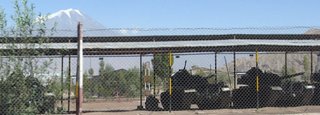

Posted by
steve
at
4:43 AM
0
comments
![]()
Hiking the Kackar (pronounced "catch-car")
 Together with the Spaniards, Alejandro and Belen, we labored through some incredibly sketchy mountain roads to get to the hiking base in the tiny town of Barhal. From there we hiked a couple days up the mountains through hamlets that cling to the mountainside for no apparent reason. We had some real excitement when our guide motioned that we should go and climb up to a lake and then follow the trail over the next hill and he'd meet usfor lunch. "1 hour". Haha. We made it up to a lake and then took a trail over a ridge that left us a good 500 feet above the meadow we were to meet him in. No problem except the trail ended and we had to clambor down a steep incline with poor footing. Oh and the rain started. Good times.
Together with the Spaniards, Alejandro and Belen, we labored through some incredibly sketchy mountain roads to get to the hiking base in the tiny town of Barhal. From there we hiked a couple days up the mountains through hamlets that cling to the mountainside for no apparent reason. We had some real excitement when our guide motioned that we should go and climb up to a lake and then follow the trail over the next hill and he'd meet usfor lunch. "1 hour". Haha. We made it up to a lake and then took a trail over a ridge that left us a good 500 feet above the meadow we were to meet him in. No problem except the trail ended and we had to clambor down a steep incline with poor footing. Oh and the rain started. Good times.  We eventually made it down and the only casualty was my right sandal which is now held together with twine expertly fashioned by Mary. But it is a beautiful mountain range and we had a great time.
We eventually made it down and the only casualty was my right sandal which is now held together with twine expertly fashioned by Mary. But it is a beautiful mountain range and we had a great time.  Best part was when Mary and Belen busted out the yoga moves on each other. Life really doesn't get much better than this.
Best part was when Mary and Belen busted out the yoga moves on each other. Life really doesn't get much better than this. 
Although it would have if the pasta had pasta sauce. Notes to self next time we negotiate a hiking package: make sure the pasta comes with sauce, make sure the meat is more than 1 stick of salami for 4 people, we don't need 3 pounds of cheese or a dozen loafs of bread... 
Posted by
steve
at
4:39 AM
0
comments
![]()
Disappointment
We had read that travelling the Black Sea coast is really nice, so we headed out to the first town where we'd start our journey. We met a Spanish couple, Belem and Alejandro, who had the same plan. But when we made it to Amasara, we found that the road to the next town along the coast had just washed out. Long story short, we said forget it and decided that we'd travel overnight together to Trabzon, well down the coast.In the meantime, a local girl who was on the same bus had been helping us and so we took her to lunch. She picked a place overlooking the beach with great fish and salad.

Posted by
steve
at
4:36 AM
0
comments
![]()
Cousın Fred and the Smiths from Safranbolu
 Sometimes you just have to pay for the kitsch. Mary was looking at a plant growing up a wall and was immediately accosted by a raggedy old woman who was spewing Turkish so fast I wonder if she even knew what she was saying. She dragged Mary forcibly by the arm while jabbing her in the buttocks to these painted egg-shaped ceramics. Finally, she found a busted one to show us that the vine grows from a seed inside the egg. So there went another hard earned 2 Turkish lire. Hopefully our new friend, named Cousin Fred, will survive the postal service.
Sometimes you just have to pay for the kitsch. Mary was looking at a plant growing up a wall and was immediately accosted by a raggedy old woman who was spewing Turkish so fast I wonder if she even knew what she was saying. She dragged Mary forcibly by the arm while jabbing her in the buttocks to these painted egg-shaped ceramics. Finally, she found a busted one to show us that the vine grows from a seed inside the egg. So there went another hard earned 2 Turkish lire. Hopefully our new friend, named Cousin Fred, will survive the postal service.
Oh yeah, the town is famous for saffron, go figure.
Posted by
steve
at
4:33 AM
0
comments
![]()
Safranbolu
Everyone is really excited about this town Safranbolu near the Black Sea coast. It's one of the must see sites and all the Turkish tourists take over the hotels on weekends. Why? Because it has a cute old village with famed "Ottoman" architecture. We couldn't figure out for a long time what the big deal is. These Ottoman houses look a lot like older western homes in the UK, western Europe or east coast US. In fact, our hotel seemed very much like a ski lodge up in Tahoe. But I guess it's a big deal when half the country is living in either concrete bunkers or shacks made of dry stacked rock and heated by hay and dung.
Posted by
steve
at
4:28 AM
0
comments
![]()





